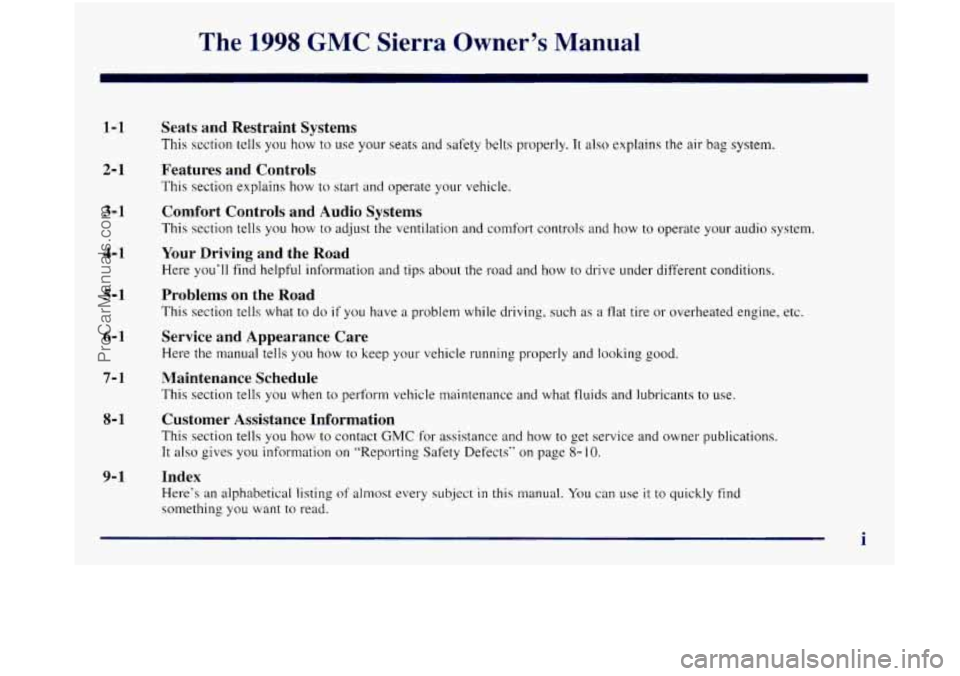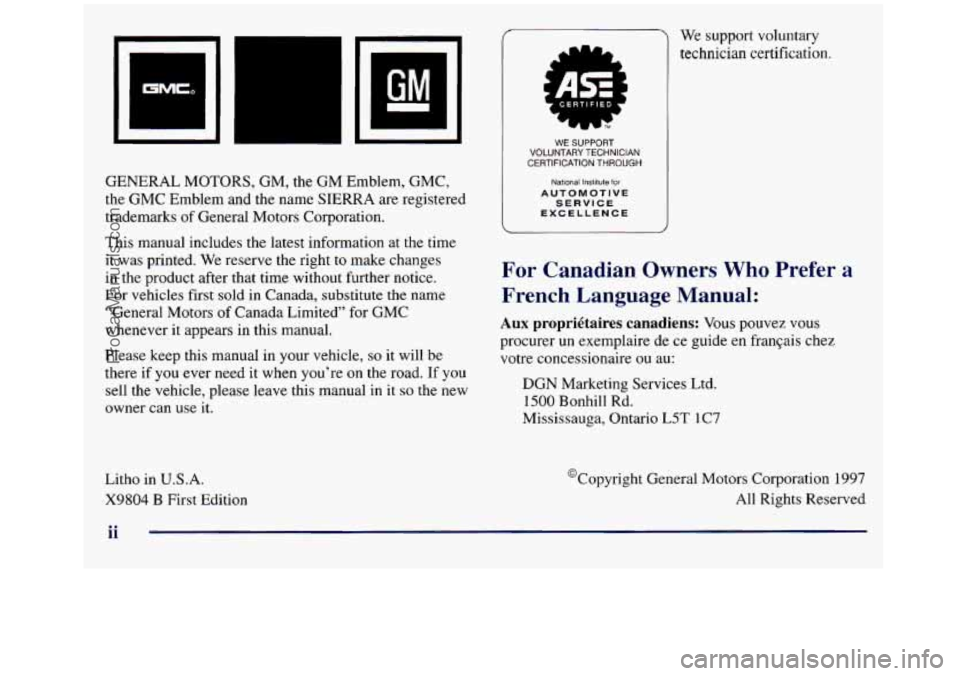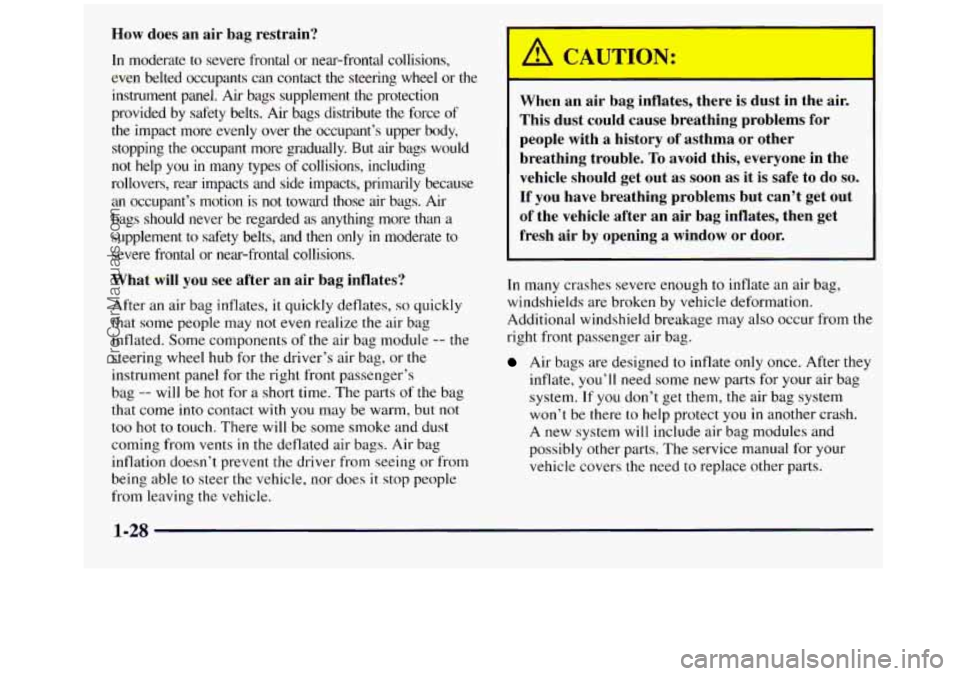1998 GMC SIERRA service
[x] Cancel search: servicePage 7 of 452

The 1998 GMC Sierra Owner's Manual
1-1
2- 1
3- 1
4- 1
5-1
6-1
7-1
8- 1
9-1
Seats and Restraint Systems
This section tells you how to use your seats and safety belts properly. Tt also explains the air bag system.
Features and Controls
This section explains how to start and operate your vehicle.
Comfort Controls and Audio Systems
This section tells you how to adjust the ventilation and comfort controls and how to operate your audio system.
Your Driving and the Road
Here you'll find helpful information and tips about the road and how to drive under different conditions.
Problems on the Road
This section tells what to do if you have a problem while driving? such as a flat tire or overheated engine, etc.
Service and Appearance Care
Here the manual tells you how to keep your vehicle running properly and looking good.
Maintenance Schedule
This section tells you when to perform vehicle maintenance and what fluids and lubricants to use.
Customer Assistance Information
This section tells you how to contact GMC for assistance and how to get service and owner publications.
It also gives you information on "Reporting Safety Defects" on page 8- 10.
Index
Here's an alphabetical listing of almost every subject in this manual. You can use it to quickly find
something you want to read.
i
ProCarManuals.com
Page 8 of 452

GENERAL MOTORS, GM, the GM Emblem, GMC,
the GMC Emblem and the name SIERRA are registered
trademarks of General Motors Corporation.
This manual includes the latest information at the time
it was printed, We reserve the right
to make changes
in the product after that time without further notice.
For vehicles first sold in Canada, substitute the name
“General Motors of Canada Limited” for GMC
whenever
it appears in this manual.
Please keep this manual in
your vehicle, so it will be
there
if you ever need it when you’re on the road. If you
sell the vehicle, please leave this manual in it so the new
owner can use
it.
Litho in U.S.A.
X9804 B First Edition
WE SUPPORT VOLUNTARY TECHNICIAN
CERTIFICATION THROUGH
National Institute far
AUTOMOTIVE
SERVICE
EXCELLENCE
We support voluntary
technician certification.
For Canadian Owners Who Prefer a
French Language Manual:
Aux propribtaires canadiens: Vous pouvez vous
procurer
un exemplaire de ce guide en fraqais chez
votre concessionaire
ou au:
DGN Marketing Services Ltd.
1500 Bonhill Rd.
Mississauga, Ontario
L5T IC7
@Copyright General Motors Corporation
1997
All Rights Reserved
ii
ProCarManuals.com
Page 40 of 452

How does an air bag restrain?
In moderate to severe frontal or near-frontal collisions,
even belted occupants can contxt the steering wheel or the
instrument panel.
Air bags supplement the protection
provided by safety belts. Air bags distribute the force of
the impact more evenly over the occupant’s upper body,
stopping the occupant more gradually. But air bags would
not help you in many types of collisions, including
rollovers, rear impacts and side impacts, primarily because
an occupant’s motion is not toward those air bags. Air
bags should
never be regarded as anything more than a
supplement to safety belts, and then only
in moderate to
severe frontal or near-frontal collisions.
What will you see after an air bag inflates?
After an air bag inflates, it quickly deflates, so quickly
that some people may not even realize the air bag
inflated. Some components of the air bag module
-- the
steering wheel hub for the driver’s air bag, or
the
instrument panel for the right front passenger’s
bag
-- will be hot for a short time. The parts of the bag
that come into contact with
you may be warm, but not
too hot to touch. There will be some smoke and dust
coming from vents
in the deflated air bags. Air bag
inflation doesn’t prevent the driver from seeing or from
being able to steer
the vehicle, nor does it stop people
from leaving the vehicle.
When an air bag inflates, there is dust in the air.
This dust could cause breathing problems for
people with a history of asthma or other
breathing trouble,
To avoid this, everyone in the
vehicle should get out as soon as it
is safe to do so.
If you have breathing problems but can’t get out
of the vehicle after an air bag inflates, then get
fresh air by opening
a window or door.
In many crashes severe enough to inflate an air bag,
windshields are broken by vehicle deformation.
Additional windshield breakage may also occur from the
right front passenger air bag.
Air bags are designed to inflate only once. After they
inflate,
you’ll need some new parts for your air bag
system.
If you don’t get them, the air bag system
won’t be there to help protect you
in another crash.
A new system will include air bag modules and
possibly other parts. The service manual for your
vehicle covers the need to replace other parts.
ProCarManuals.com
Page 41 of 452

0 Your vehicle is equipped with a crash sensing and
diagnostic module, whch records information about
the air
bag system. The module records information
about the readiness
of the system, when the sensors are
activated
and driver’s safety belt usage at deployment.
switch
on the instrument. panel that you can use to
turn
off the passenger’s air bag. But use this switch
only when you want to secure a rear-facing child
restraint at the right front passenger’s position. See
“Securing a Child Restraint
in the Right Front Seat
Position”
in the Index for more on this, including
important safety information.
0 Unless you have a Crew Cab, your vehicle has a
A CAUT-ON:
If the right front passenger’s air bag is turned
off, the person sitting there won’t have the extra
protection
of an air bag. In a crash, the air bag
wouldn’t be able to inflate and help protect the
person sitting there. Make sure the
air bag is
turned on unless
you are using a rear-facing child
restraint in the right front seat position.
0 Let only qualified technicians work on your air bag
system. Improper service can mean that your air bag
system won’t work properly. See your dealer
for service.
1-29
ProCarManuals.com
Page 42 of 452

I NOTICE:
If you damage the covering for the driver’s or the
right front passenger’s air bag, the bag may not
work properly. You may have to replace the air
bag module in the steering wheel or both the air
bag module and the instrument panel for the right front passenger’s air bag.
Do not open or
break the air bag coverings.
Servicing Your Air Bag-Equipped Vehicle
Air bags affect how your vehicle should be serviced.
There are parts
of the air bag system in several places
around your vehicle. You don’t want the system to
inflate while someone is working on your vehicle. Your
dealer and the service manual have information about
servicing your vehicle and the air
bag system. To
purchase a service manual, see “Service and Owner
Publications”
in the Index.
If your vehicle ever gets into a lot of water -- such as
water up to the carpeting or higher -- or if water enters
your vehicle
and soaks the carpet, the air bag controller
can be soaked and ruined. If this ever happens, and then
you start your vehicle, the damage could make the air
bags inflate, even if there’s no crash.
You would have to
replace the air bags
as well as the sensors and related
parts. If your vehicle is ever
in a flood? or if it‘s exposed
to water that soaks the carpet, you can avoid needless
repair costs
by turning off the vehicle immediately.
Don’t
let anyone start the vehicle, even to tow it, unless
the battery cables are first disconnected.
I
For up to 10 minutes after the ignition key is
turned off and the battery is disconnected, an air
bag can still inflate during improper service. You
can be injured if you are close to an air bag when
it inflates. Avoid
wires wrapped with yellow tape
or yellow connectors. They are probably part of
the
air bag system. Be sure to follow proper
service procedures, and make sure the person
performing work for you
is qualified to do so.
~~
The ail- bag system does not need regular maintenance.
1-30
ProCarManuals.com
Page 76 of 452

If the air bag readiness light ever comes on when
you have turned
off the air bag, it means that
something may be wrong with the air bag system.
The right front passenger’s air bag could inflate
even though the switch is off.
If this ever
happens, don’t secure a rear-facing child
restraint in your vehicle until you have your
vehicle serviced.
You’ll be using
the lap-shoulder belt. See the earlier part
about
the top strap if the child restraint has one. Be sure
to follow
the instructions that came with the child
restraint. Secure the child in the child restraint when and
as the instructions say.
1. If your vehicle has air bags and you are using a
rear-facing child restraint in this seat, make sure the
air bag
is turned off. If your child restraint is
forward-fixing, always move the seat as far back as
it will go before securing it in this seat. (See “Seats”
in the Index.)
2. Put the restraint on the seat.
3. Pick up the latch plate, and run the lap and shoulder
portions of
the vehicle’s safety belt through or
around the restraint. The. child restraint instructions
will show
you how.
If the shoulder belt goes in front of the child’s face or
neck, put
it behind the child restraint.
4. Buckle the belt. Make sure the release button is
positioned so you would be able to unbuckle the
safety belt quickly
if you ever had to.
1-64
ProCarManuals.com
Page 90 of 452

~ Power Door Locks (If Equipped)
Press the bottom of the
power door lock switch,
marked
LOCK, on either
front door to lock all the
doors at once. Press the
ribbed side
of the switch to
unlock all the doors at once.
Leaving Your Vehicle
If you are leaving the vehicle, take your keys, open your
door and set the locks from inside. Then get out and
close the door.
Keyless Entry System (If Equipped)
If your vehicle has this option, you can lock and unlock
your doors from about
3 feet (1 m) up to 30 feet (9 m)
away using the remote keyless entry transmitter supplied
with your vehicle. Your
interior lamps will be illuminated for a set period
of time when the transmitter signal is received by the
Keyless Entry System.
In addition, your vehicle’s horn
will chirp if you press the
LOCK button twice, to let you
know that the doors have locked.
Your keyless entry system operates on a radio frequency
subject to Federal Communications Commission (FCC)
Rules and with Industry Canada.
This device complies with
Part 15 of the FCC Rules.
Operation is subject to the following two conditions:
(1) this device may not cause harmful interference, and
(2) this device must accept any interference received,
including interference that may cause undesired operation.
This device complies with RSS-210
of Industry Canada.
Operation is subject to the following two conditions:
(1) this device may not cause interference, and
(2) this
device must accept any interference received, including
interference that may cause undesired operation
of
the device.
Changes or modifications to this system by other than an
authorized service facility could void authorization
to
use this equipment.
2-6 -
ProCarManuals.com
Page 91 of 452

This system has a range of about 3 feet (1 m) up to
30 feet (9 m). At times you may notice a decrease in
range. This is normal for any remote keyless entry
system.
If the transmitter does not work or if you have
to stand closer to your vehicle for the transmitter to
work, try this:
0 Check to determine if battery replacement or
transmitter resynchronization is necessary. See the
instructions that follow.
Check the distance. You may be too far from your
vehicle.
You may need to stand closer during rainy
or snowy weather.
Check the location. Other vehicles or objects may be
blocking the signal. Take a few steps to the left or
right, hold the transmitter higher, and try again.
If you're still having trouble, see your dealer or a
qualified technician for service.
Operation
To unlock the driver's door, press the UNLOCK button.
The interior lamps
will come on for 40 seconds or until
the ignition is turned on. if you press the UNLOCK
button again within five seconds, all the remaining doors
(except the third door)
will unlock. Press the
LOCK button to lock
all the doors (except
the third door). The interior lamps will come on
for
two seconds as soon as all the doors are closed. If you
press the LOCK button twice the horn will chirp to
confirm that the doors have locked.
If you do not want the horn to chirp as a confirmation
that the doors have locked or unlocked, please consult
your dealer.
Matching Transmitter(s) To Your Vehicle
Each remote keyless entry transmitter is coded to
prevent another transmitter from unlocking your vehicle.
If a transmitter is lost or stolen, a replacement can be
purchased through your dealer. Remember to bring any
remaining transmitters
with you when you go to your
dealer. When the dealer matches the replacement
t~-ansmitter to your vehicle, any remaining transmitters
must also be matched. Once your dealer has coded the
new transmitter, the lost transmitter
will not unlock your
vehicle. Each vehicle can have only
four transmitters
matched to
it.
2-7
ProCarManuals.com